Additional Accessibility Guides
Teams and Zoom
 Making a virtual meeting or presentation accessible includes all attendees equitably. Consider the following tools and best practices for Zoom and Teams.
Making a virtual meeting or presentation accessible includes all attendees equitably. Consider the following tools and best practices for Zoom and Teams.
On this page:
Before Meeting
Before a meeting, consider the following to ensure your meeting includes everyone:
Include relevant information in the meeting invitation
Copy Zoom meeting invitation and distribute with meeting invitation.

Use Outlook to schedule a Teams meeting by toggling on Team meeting in Outlook.
![]()
Share material in advance
If your event includes material, share it in advance.
This helps:
- Attendees follow along.
- People consume information at their pace.
- Improve comprehension and understanding by allowing people to make notes and annotations instead of frantically copying down the information.
- People who prefer to print material.
- People who wish to do preparatory reading.
- Assistive technology users to access and navigate the content.
- Interpreters, captioners, and transcribers to prepare and know names, terminology, and details.
If there is no material, consider sending a read-ahead or agenda. No one likes surprises. In the context of a class, your content will likely be related to the readings or material on Brightspace, so you may not have to explicitly create anything extra.
As always, ensure what you are sharing is accessible.
Mute on entry
For large groups, it may be best to have attendees muted when they enter to reduce confusion and crosstalk. People can unmute as needed later.
When setting up a Zoom meeting, toggle on Mute all participants when they join a meeting. Learn how to mute all Zoom participants.
In Teams, select Meeting options to set audio and video permissions. Learn more about managing attendee audio in Teams.
Enable automatic captions

In Zoom, ensure captions are enabled. In the Zoom toolbar, click the captions button and select Enable captions.
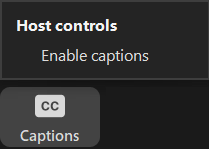
This allows viewers to enable captions on their device. Learn more about Zoom automatic captions.

In Teams, select … More and select Settings > Accessibility. In the Accessibility sidebar, toggle Always show captions in my meetings on.
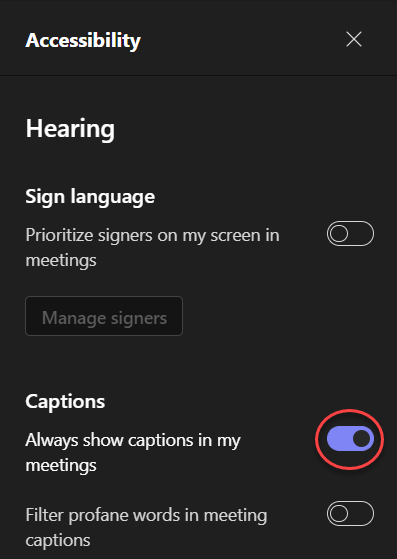
Use live captions in Microsoft Teams meetings
During Meeting
Make a plan, ask for input, and communicate with attendees
Outline the agenda, structure, and expectations of the Zoom session to help with accessibility and anxiety and ensure a smooth flow. Indicate if you plan to use breakout rooms, if there will be polls, and how you would like questions/comments to be communicated.
Consider:
- Asking how attendees would prefer to communicate and come to a group agreement about communicating.
- Some students may not find it easy to access the chat window and video simultaneously.
- Some students may prefer to ask questions via chat.
- Repeating questions aloud before answering them.
- This allows those not looking at the chat to know the question you are about to answer.
- Asking a volunteer to monitor the chat and ask them to notify you of questions.
- Encouraging participants to mute their microphone when they are not speaking.
Recording

To record a Zoom meeting:
- Select Record on the Zoom toolbar.
- Recording can be paused and stopped on the Zoom toolbar.
- The recording will be saved in the default location (Documents folder / Zoom / Folder with meeting name, date, and time.)

To record a Teams meeting:
- Under More in the meeting controls, open the Record and Transcribe menu.
- Select Start recording.
- Set Spoken language and select Confirm.
- Recording a meeting automatically starts Transcription.
The recording will be available in the Teams chat for the meeting as well as the host’s OneDrive Recordings folder.
Mute all participants

In Zoom, open the participants panel and select Mute All.
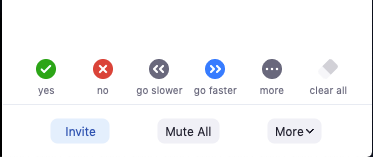
If appropriate, ensure Allow participants to unmute is checked.Learn more about muting participants in Zoom.

In Teams, select People and click on the … More options menu in the top right.Select Disable mic for attendees.
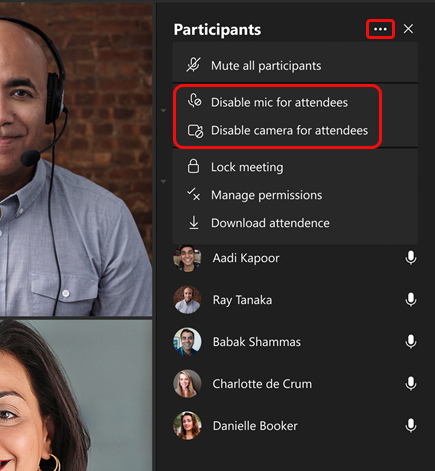
Hosts can then allow individual users to unmute, or enable mic for attendees using the same menu. Learn more about managing attendees in a Teams meeting.
Avoid complicated virtual backgrounds
Animated virtual backgrounds may be distracting for some and could cause anything from motion sickness to seizures for others. If you want a virtual background, use blur or other solid colour.

In Zoom:
- Via the video settings menu, select Choose Virtual Background…
- The Zoom settings window will open to Background & Effects where you can choose a background.
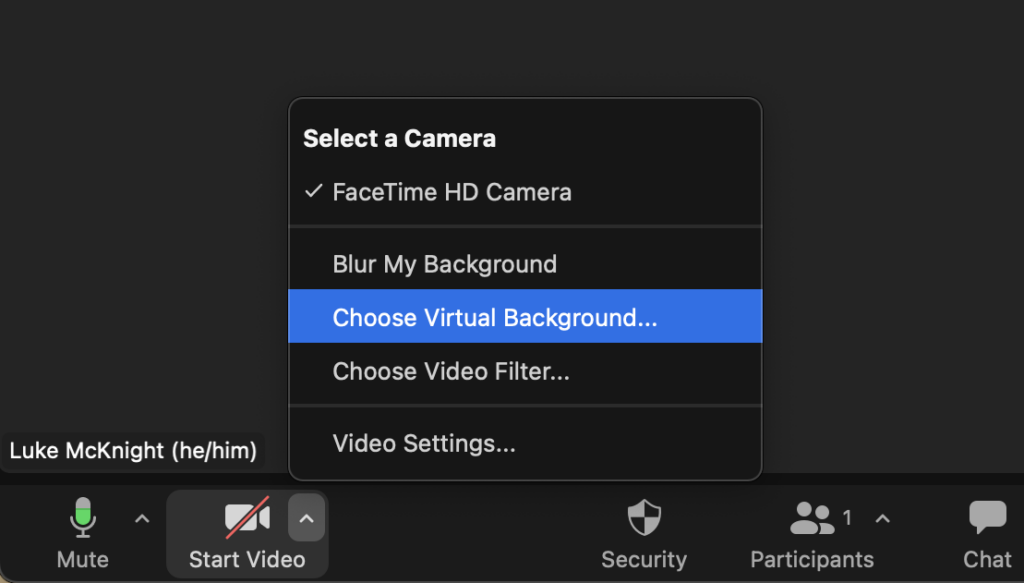
Read more about changing Zoom virtual background.

In Teams:
- While you’re setting up your video and audio before joining a meeting, select Background filters.
- Your background options will display on the right.
- Select Blur to blur your background.
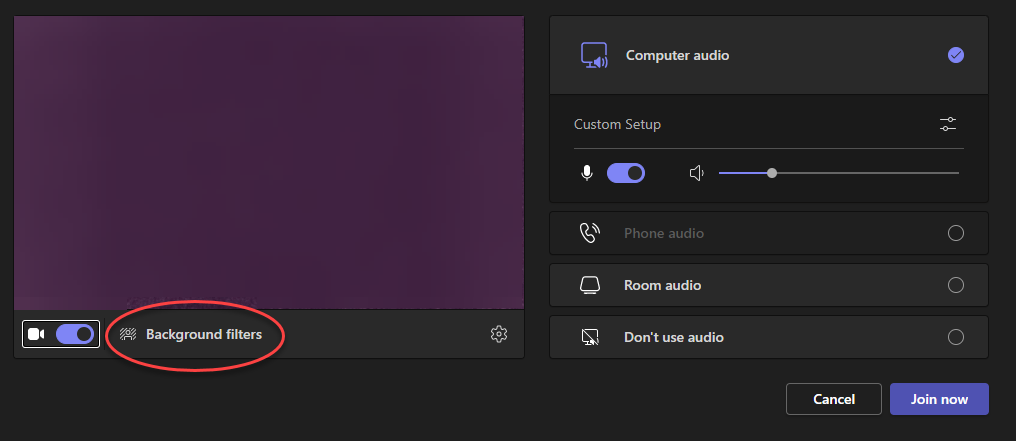
How to set a background filter in Teams.
Use tools to highlight specific attendees
In Zoom consider pinning participants’ videos and allowing multi-pin. This will help attendees focus and/or pin the presenter and an interpreter.
In Teams, use Spotlight and Pin for presenters and interpreters.
Present with your audience in mind
Learn more about inclusive content delivery.
Additional Considerations
If you are unsure how to assist a participant, ask them. They may have encountered a similar barrier before and may recall a solution.
Ask participants if they would like any help or if anything is unclear.
Be patient. Everyone faces unique circumstances and some may need additional time and patience.
Respect participants desire to share or remain private.
If presenting a PowerPoint, consider Present Live: Engage your audience with Live Presentations and Present from PowerPoint Live in Microsoft Teams.
After Meeting
Following a meeting there are a number of useful resources that can be shared:
Chat

To save a Zoom meeting chat:
- Open the Chat panel.
- Select the … More menu beside the meeting room name.
- Choose Save chat.
- The chat will be saved as a text file in the default location (Documents folder / Zoom / Folder with meeting name, date, and time.)
It is possible to disable the chat for a meeting to prevent participants from chatting with one another.

In Teams, meeting chats are saved automatically in each user’s chat window under the name of the meeting. The chat can be manually copy and pasted into a document, however some formatting may be distorted.
Transcript

To save the transcript in Zoom:
- Transcription and/or Closed Captioning must be enabled.
- Open the Captions menu on the toolbar and select Show full transcript
or select the Transcript button from the toolbar. - At the bottom of the Transcript panel, select Save transcript.
- The transcript will be saved as a text file in the default location (Documents folder / Zoom / Folder with meeting name, date, and time.)

To save a transcript in Teams:
- Transcription must be turned on for the meeting.
- After the meeting, the Transcript will be available for download in the meeting chat. Depending on settings, the Transcript may only be available to the meeting host to download.
Consider sending a follow-up email after the meeting has concluded. A follow-up email could include:
- Reminders
- Action items
- Links or other resources shared in chat or discussions.
- A useful method might be to look at the saved chat and glean links and talking points from that record.
- Where and when appropriate, share a captioned video recording.
- Presentation material or related resources, even if you shared them prior to the meeting.
For repeating meetings, check in with attendees periodically for feedback on what is working or what changes they might benefit from. Ask attendees about pace and breaks. Review protocols for communicating (raising hands, use of chat, etc.) and ask for suggestions.
A text equivalent of audio content in a video, displayed synchronously. Closed captions are toggled on or off by viewers, as opposed to open captions that are burned into the video and always displayed.

